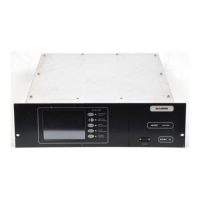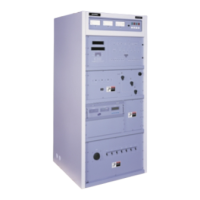A VSWR condition causes a RED “VSWR Fault” indication by
forcing the Q output of the Pulse Stretcher or the Latch HIGH
and the output of OR gate U37-11 HIGH.
Q.5.4.5 VSWR Self-Test Circuit
The “VSWR Self-Test” performs a test of VSWR logic AUTO-
MATICALLY each time AC power is applied to the transmitter.
The operator can also perform a VSWR Self-Test MANUALLY
at any time. The “Self-test” results are available on a Color-
Stat™ panel indicator, or as a remote “VSWR Self-Test
Pass/Fail” indication.
If all VSWR logic on the Output Monitor and LED Board is
working properly when a VSWR Self-Test is performed, BOTH
the “Antenna” and “Bandpass” indicators will indicate RED for
one-half second and the “VSWR Sensor Status” will flash RED
momentarily, then all three indicators will indicate GREEN.
If either the “Antenna” or “Bandpass” indicator remains RED,
a VSWR logic fault is indicated. The transmitter should not be
operated until the VSWR logic faults are corrected.
Q.5.4.6 VSWR Self-Test, Circuit Description
The following circuit descriptions refer to Figure Q-6, VSWR
Self-Test Circuit, Simplified Functional Diagram, or to sheet 2
of the LED Board schematic diagram.
Any time a VSWR self-test is initiated, a 10 millisecond logic
LOW pulse is generated by one-shots U29A/B. This logic LOW
pulse to the Output Monitor activates a circuit which simulates
aVSWR“hit” by applying +5 VDC to both VSWR detector
inputs on the Output Monitor.
At the same time, a 0.5 millisecond logic LOW pulse is gener-
ated to “reset,” then “clock” latch U42A on the LED Board.
Latch U42A is both a VSWR Self-Test “Detector” and Status
Indicator latch. If all VSWR logic is operating properly, a
“VSWR Fault-H” logic signal will appear at the D input before
the Latch “Clock”input occurs. When the latch is “clocked,”the
Q output will go HIGH and the NOT-Q output will go LOW.
The latch output will then illuminate only the GREEN LED
section and there will be NO remote “VSWR Self-TestIndicate”
output.
If NO VSWR “Hit” is detected, indicating a logic fault, the D
input will be LOW. When the latch is “clocked,” the Q output
will go LOW and the NOT-Q output will go HIGH. The Color-
Stat™ panel LED will indicate RED and a logic HIGH output
will be sent to the External Interface to provide a “VSWR
Self-Test Indicate” output.
Q.5.4.6.1 Manual VSWR Self-Test Inputs
Depressing the “Manual Test” switch(S2)ontheColorStat™
panel will ground U25-9 and the output (pin 8) will go LOW.
The other input to this U25 gate is controlled through the
External Interface board. A HIGH-to LOW transition at the A
input will trigger One-Shot U29B. The One-Shot will generate
two 10 millisecond logic pulses at its outputs, a logic HIGH
pulse at its Q output (pin 5) and a logic LOW pulse at its NOT-Q
output (pin 12).
Q.5.4.6.2 “Turn-on Induced” VSWR Self-Test Input Circuit
Each time AC power is applied or re-applied to the transmitter,
the“Supply Fault-L”signalfrom theController goes fromLOW
to HIGH after a delay of a few seconds. Buffer/Driver U25-11
and an R-C network delay the transition to allow the CLEAR
inputs of one-shots U29A/B in the VSWR logic to go HIGH,
then the LOW-to-HIGH transition at the “B” input triggers
one-shot U29A. When triggered, one-shot U29A generates 10
millisecond pulses at its Q and NOT-Q outputs (pins 13 and 4).
Q.5.4.6.3 Self-Test Pulse To Output Monitor
Refer to Figure Q-6. A logic LOW pulse from either the turn-on
induced self test one-shot U29A or the manual self-test one shot
U29B causes U25-6 to go LOW. This is the self-test pulse to the
output monitor.
Each time a 10 millisecond logic HIGH pulse goes to the Output
MonitorfromU29A/B, a 0.5 mseclogicLOW pulseis generated
by U50-11 and U8-8.
1st Latch AND 2nd NOR Status
1Shot Not-Q Gate Invert RED Latch 1Shot Gate GRN Ind.
Cond. Not-Q Out Out Out LED QOut QOut Out LED Color
Normal HIGH HIGH HIGH LOW OFF LOW LOW HIGH ON GREEN
1st. LOW HIGH LOW HIGH ON LOW LOW HIGH ON YELLOW
2nd. HIGH HIGH HIGH LOW OFF LOW HIGH LOW OFF OFF
Repeat LOW LOW LOW HIGH ON HIGH HIGH LOW OFF RED
Latch HIGH LOW LOW HIGH ON HIGH LOW LOW OFF RED
Conditions are:
Normal: Normal operation (no faults)
1st: Fault starts first one-shot (Cycles transmitter OFF for 4.7 seconds then starts turn-on sequence).
2nd: Second one-shot starts 2-1/2 second time-out.
Repeat: Repeated Fault occurred and Latch changed state.
Latch: Both one-shots have timed out, but Fault Status is still Latched.
Note that when the RED LED is ON an External “Type 2 Fault” status output is also provided (this occurs for both YELLOW and
RED status panel indications).
Table Q-2. Type 2 Fault Status
Section Q - LED Board (A32)
Rev. R: 11-11-96 888-2297-002 Q-15
WARNING: Disconnect primary power prior to servicing.
